Have you ever wondered whether you can put a 5th wheel hitch on a flatbed?
It’s an interesting question and one that deserves some exploration.
In this blog post, we’ll take a closer look at the feasibility of doing this and see the implications.
Can You Put A 5th Wheel Hitch On A Flatbed?
A flatbed may indeed be attached to a fifth-wheel hitch.
Yes, it is possible to put a 5th wheel hitch on a flatbed.
This type of hitch is designed to be mounted on the bed of a truck and is typically used for towing large trailers such as travel trailers and fifth-wheel trailers.
In order to install a 5th wheel hitch on a flatbed, you will need to purchase a mounting kit that is specifically designed for the type of flatbed that you have.
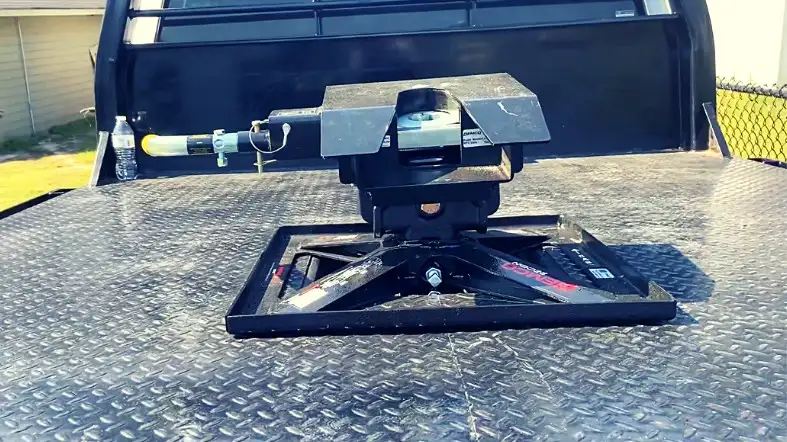
This kit will include all the necessary hardware and instructions for installing the hitch.
Additionally, you will need to ensure that your flatbed is rated for the weight of the trailer that you will be towing.
It’s always best to consult with a professional to ensure that the hitch is installed correctly and safely.
How to Install A Fifth Wheel Hitch on A Flatbed?
In order to properly install a fifth wheel hitch on a flatbed, you will need the following tools:
- A drill
- A ratchet set
- A socket set
- Wrenches
- A tape measure
- A level
If you have all of the necessary tools, you’re ready to get started.
Now follow the below tools to install your hitch.
Step 1: Park Your Truck in a Safe and Level Location
First things first, you’ll need to park your truck in a safe location.
Once your truck is parked, be sure to set the parking brake and put chocks under the wheels to prevent the truck from rolling.
Step 2: Measure for Proper Hitch Placement
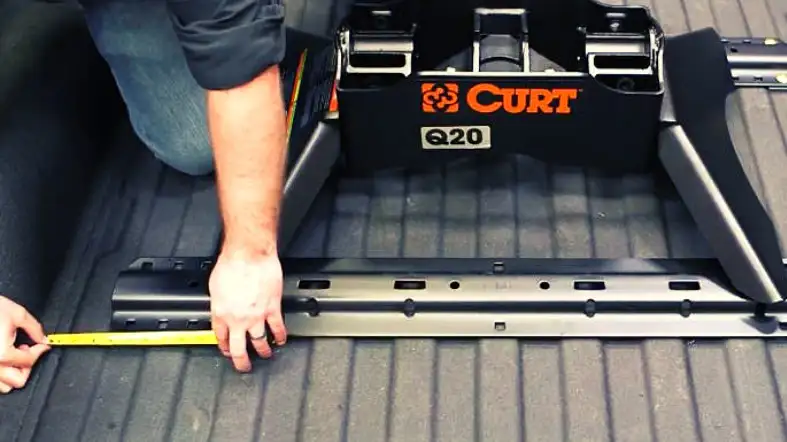
Using a tape measure, you’ll need to measure from the center of the rear axle to the back of the truck bed.
This measurement will determine where your hitch needs to be placed.
Most fifth wheel hitches will require that you place the hitch between 19 and 22 inches from the center of the rear axle.
However, it is important to consult the manufacturer’s instructions for specific placement requirements.
Step 3: Drill Holes for the Brackets
Once you have determined where to place the hitch, it’s time to drill holes for the brackets.
Be sure to use a drill bit that is slightly smaller than the bolts that will be used to secure the brackets in place.
Also, be sure to wear safety glasses to protect your eyes from flying debris.
Step 4: Attach the Brackets
Attach the brackets to the hitch using the bolts and washers that were provided.
Start by threading the bolts through the holes in the brackets.
Then, use a ratchet to tighten the bolts until the bracket is secure.
Step 5: Suspend the Fifth Wheel Hitch from the Brackets
Now suspending the fifth wheel hitch from the brackets.
This can be done by threading a chain through the holes in the hitch and attaching it to the brackets.
If you have a friend or family member to help, they can hold the hitch while you thread the chain.
Otherwise, you can use a ratchet strap to temporarily secure the hitch in place.
Step 6: Attach The Fifth Wheel Hitch to The Truck
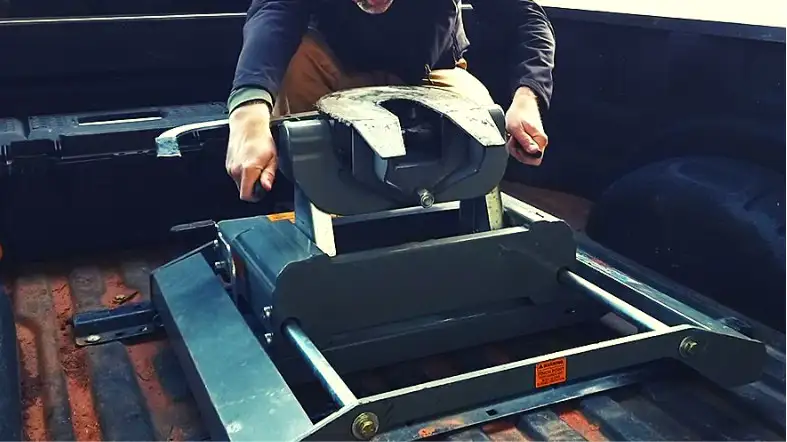
Now it’s time to attach the fifth wheel hitch to the truck.
This is done by inserting the kingpin of the trailer into the hitch.
Once the kingpin is in place, you’ll need to secure it by tightening the jaws of the hitch around the pin.
Most fifth wheel hitches will have a lever or handle that is used to tighten the jaws.
Consult the manufacturer’s instructions for specific details on how to operate your particular model.
Step 7: Test the Hitch
Now it’s time to test the hitch.
First, make sure that the parking brake is engaged and the wheels are chocked.
Then, attach the trailer to the hitch and attempt to pull it forward.
If the hitch is secure, the trailer should not move.
If you have a friend or family member to help, they can hold onto the trailer while you test the hitch.
Otherwise, you can use a ratchet strap to temporarily secure the trailer in place.
If everything looks good, you’re ready to hit the road.
Just be sure to double check all of the bolts and straps before heading out.
And, as always, drive safely!
What Height Should I Set My 5th Wheel Hitch?
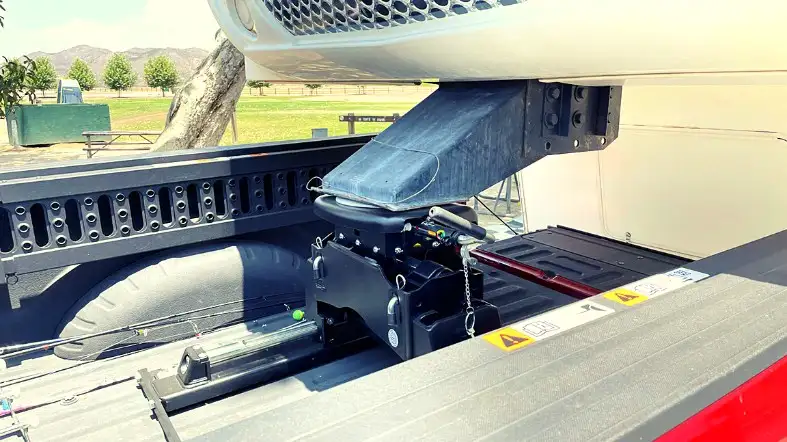
The recommended measurements vary anywhere from 38 to 52 inches.
For optimal results, we recommend a fifth wheel hitch height of between 45 and 49 inches when your rig is leveled.
The fifth wheel hitch should be set at the proper height in order to ensure safe and efficient towing.
The best way to determine the proper height is to consult the manufacturer’s instructions.
In general, the hitch should be set so that the trailer is level when it is hitched up.
This can be accomplished by adjusting the height of the hitch or by using leveling jacks on the trailer.
Once the proper height is achieved, it is important to double check all of the bolts and straps to ensure that everything is secure.
So, it is very important to ensure the hitch is properly installed and at the correct height before towing.
What Things to Consider Before Installing the Hitch on A Flatbed?
Before installing a fifth wheel hitch on a flatbed, there are a few things that you need to take into consideration.
- You need to make sure that the hitch is compatible with your truck. Some hitches are designed for specific makes and models of trucks. Others are universal and can be used with any truck.
- Ensure that the hitch is properly rated for the weight of the trailer. The weight rating is usually stamped on the hitch.
- Check that the hitch is properly installed. This includes making sure that all of the bolts are tight and that the hitch is at the proper height.
- Inspect the hitch for any signs of damage. If there are any cracks or other damage, do not use the hitch.
- Make sure that you have all the necessary tools and supplies before starting the installation. This includes a drill, ratchet, sockets, wrenches, and pliers.
- You need to make sure that the trailer is properly secured to the hitch. This includes making sure that all of the bolts are tight and that the trailer is at the proper height.
- Last, ensure the parking brake is engaged and the wheels are choked before testing the hitch.
What Are The Benefits Of Using A 5th-Wheel Hitch?
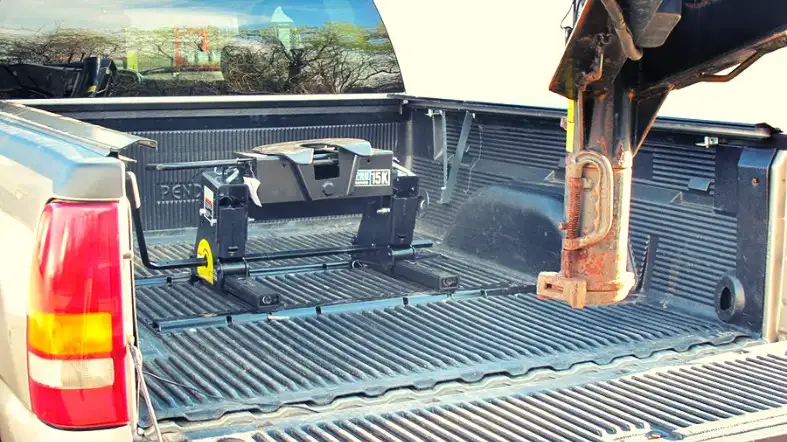
There are several benefits to using a 5th-wheel hitch, especially if you regularly haul large trailers.
Stability
One of the main benefits is that it offers more stability than a traditional trailer hitch.
This is because the 5th-wheel hitch mounts over the rear axle of your vehicle rather than at the bumper.
This provides a sturdier towing setup and can help to prevent trailer sway.
Maneuverability
Another benefit of using a 5th-wheel hitch is that it offers more maneuverability.
This is because the hitch point is closer to the center of the vehicle, giving you more control when backing up and turning.
If you regularly haul large trailers, this can be a huge advantage.
Built-in weight distribution systems
Many 5th-wheel hitches come with built-in weight distribution systems.
This can help to distribute the weight of your trailer more evenly across your vehicle, which can improve handling and braking.
How to choose A 5th Wheel Hitch On A Flatbed?
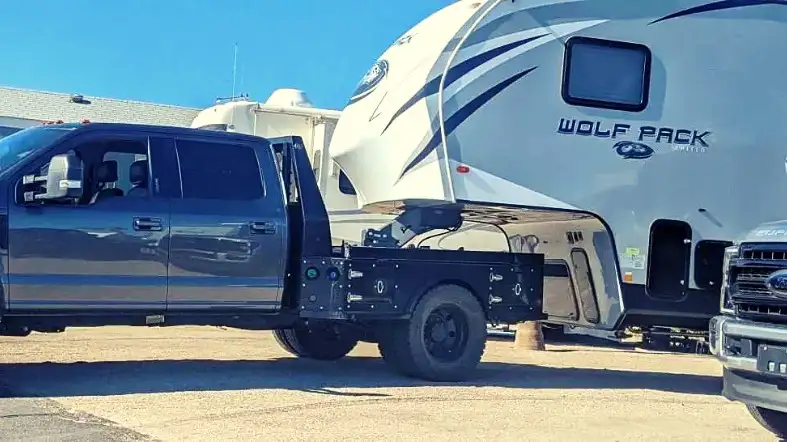
You’ll need to consider a few things before choosing a 5th-wheel hitch for your flatbed.
Weight capacity
Make sure to choose a hitch that has a weight capacity that matches or exceeds the weight of your trailer.
Type of vehicle
Some hitches are only compatible with specific vehicles.
Make sure to choose a hitch that is compatible with your vehicle.
Installation
Some hitches are easier to install than others.
If you’re not comfortable installing the hitch yourself, then make sure to choose one that comes with easy-to-follow instructions.
Cost
5th-wheel hitches can be pretty expensive.
If you’re on a budget, then make sure to choose a hitch that fits within your price range.
Brand
There are many different brands of 5th-wheel hitches on the market.
Do some research to find a brand that you trust, and that has a good reputation.
What are the challenges of using a 5th-wheel hitch?
There are a few challenges to using a 5th-wheel hitch, especially if you’re not used to hauling large trailers.
Weight
One of the main challenges is that 5th-wheel hitches are typically very heavy.
This can make them difficult to install and remove, especially if you’re doing it yourself.
Compatibility
Another challenge is that not all flatbeds are compatible with 5th-wheel hitches.
Before attempting to install it, you’ll need to ensure that your hitch is compatible with your particular flatbed.
Cost
5th-wheel hitches can also be expensive, especially if you buy a high-quality model.
If you’re on a budget, you may have better options.
As you can see, there are both benefits and challenges to using a 5th-wheel hitch.
If you regularly haul large trailers, the benefits may outweigh the challenges.
However, a traditional trailer hitch may be a better option if you’re on a budget or don’t regularly haul large trailers.
FAQs on putting a 5th wheel hitch on a flatbed
Are There Any Dangers In Utilizing A Flatbed With A Fifth-Wheel Hitch?
Some risks are associated with using a 5th-wheel hitch on a flatbed.
The most common risk is that the trailer may sway back and forth, which can be dangerous.
Other risks include the difficulty of maneuvering the trailer and the difficulty of backing up.
How Do You Properly Care For A 5th-Wheel Hitch?
To properly care for a 5th-wheel hitch, you should regularly inspect the hitch for loose bolts or other hardware.
You should also follow all local laws and regulations regarding using 5th-wheel hitches.
Finally, familiarize yourself with the tips for using a 5th-wheel hitch on a flatbed.
How Often Should You Inspect A 5th-Wheel Hitch?
It would be best if you inspected a 5th-wheel hitch before each use.
Additionally, it would be best to inspect the hitch for loose bolts or other hardware regularly.
What Are Some Troubleshooting Tips For A 5th-Wheel Hitch?
If you’re having trouble with your 5th-wheel hitch, check the bolts and other hardware to ensure they are tight.
It would be best if you also inspected the hitch for any damage.
If you’re still having trouble, consult the instructions that came with your hitch or contact the manufacturer.
How Do I Know If My 5th-Wheel Hitch Is Compatible With My Vehicle?
A. You can usually find this information in the instructions that came with your hitch.
If you can’t find the instructions, you can also check the website of the hitch manufacturer.
The final thoughts
Now you know the answer to the question “can you put a fifth wheel hitch on a flatbed” and how to install it properly.
Make sure the hitch has a weight capacity that matches or exceeds the weight of your trailer.
You should also ensure the hitch is compatible with your vehicle and that you’re comfortable installing it.
Be sure to follow all local laws and regulations regarding the use of hitches.
